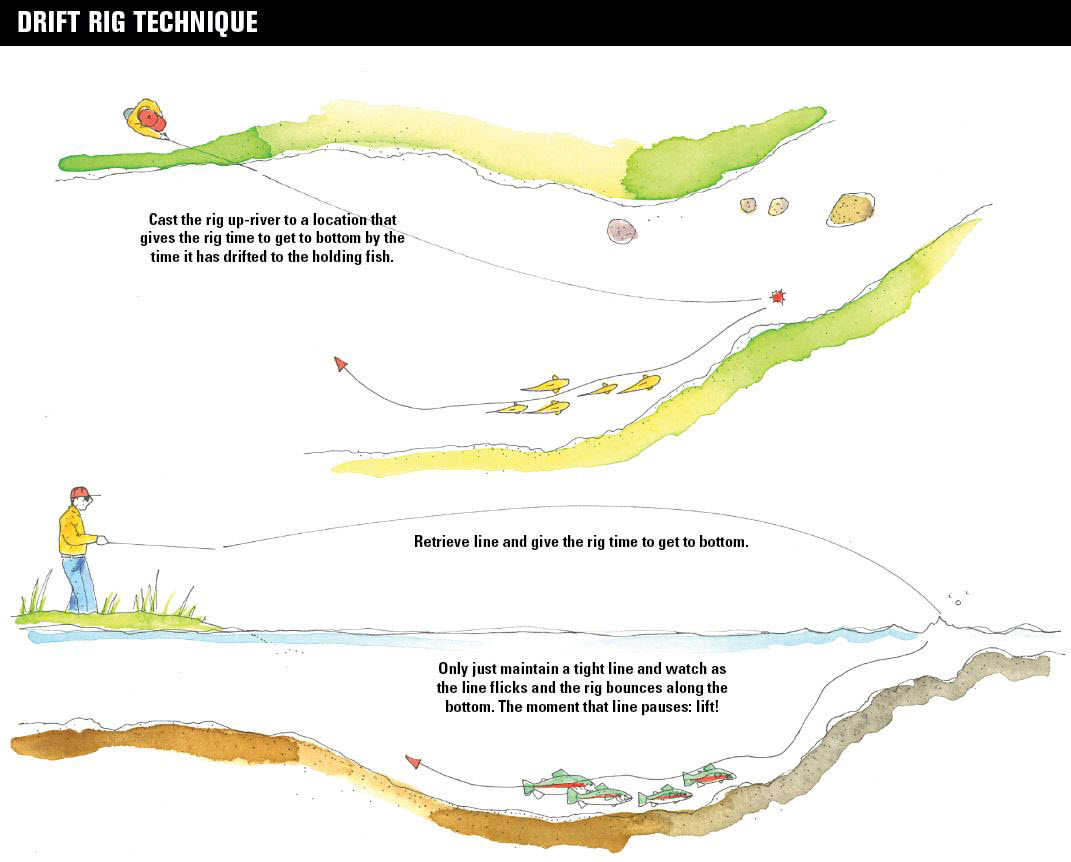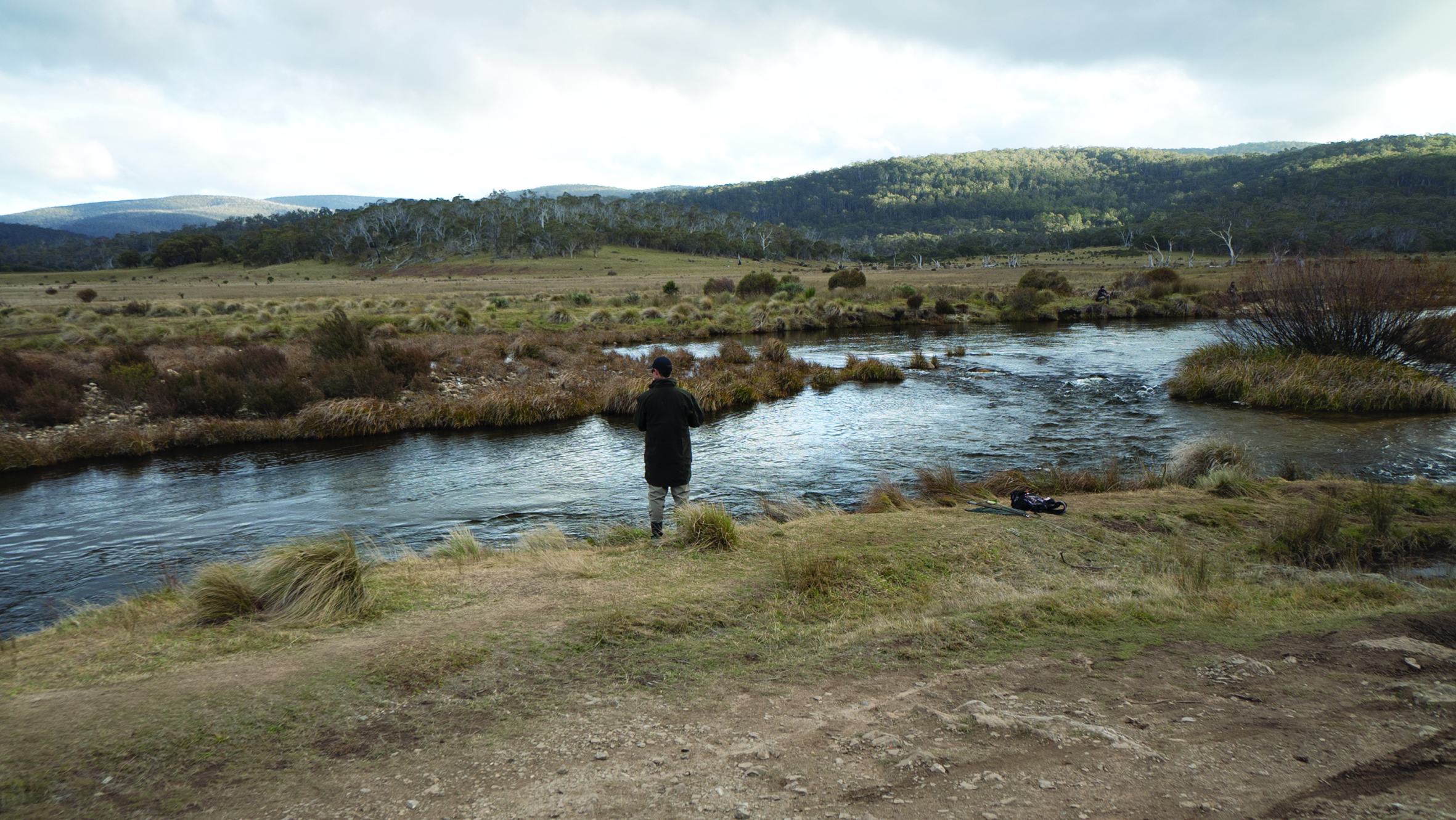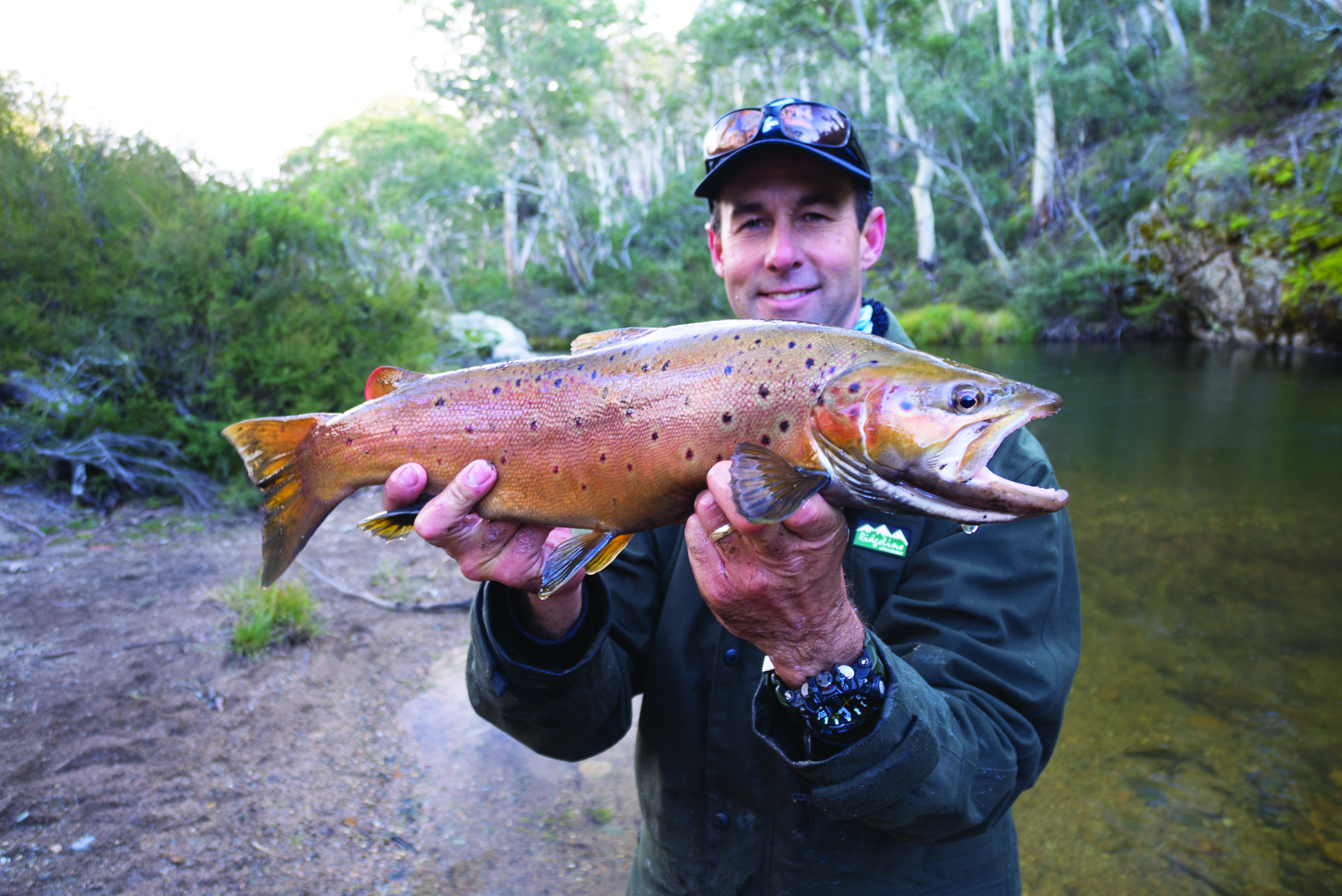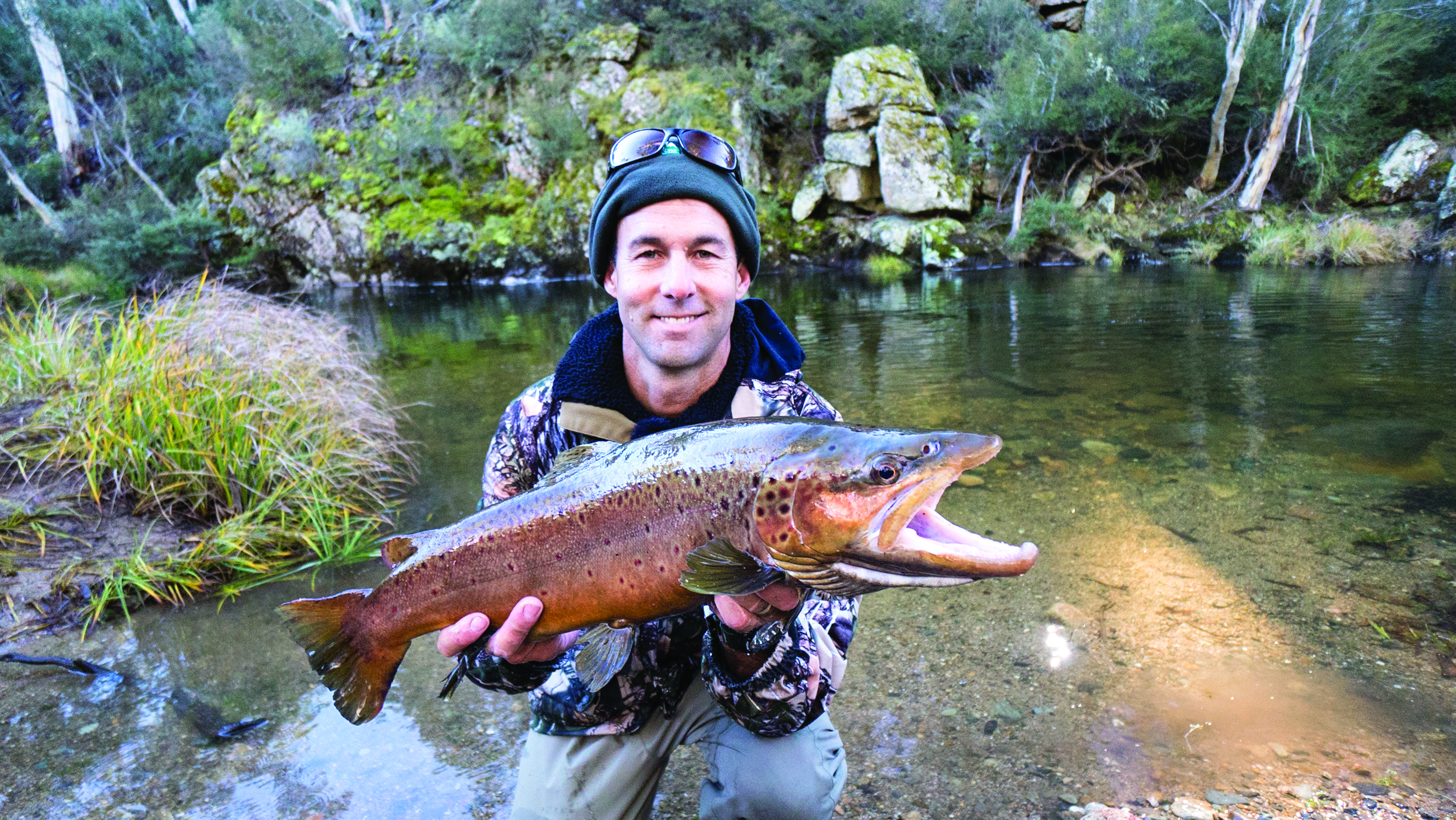In my early twenties I used to knock around with the staff at the Alpine Angler in Cooma. A then employee, Daniel, mentioned I had to have a crack at this ‘drift rigging’ technique. I was due a trip into the mountains at the start of the trout season and he told me of good numbers of rainbow trout still in the rivers. We planned a trip and I was asked to bring only a light spin outfit even though we would be using flies while targeting river fish: I was intrigued!
The trip started with a brisk run in the boat to where the Thredbo River joins Lake Jindabyne, where we anchored the boat and walked up to the first few pools. A fly angler was working a pool without success and from a cliff face above we watched as he repeatedly drifted a fly across a pod of holding rainbow trout. Daniel, a die-hard fly angler mentioned at one point that the drift depth and speed of the fly is so important in this scenario and that spin gear and the appropriate rig lends itself much better the river flow we were looking at. The fly angler eventually gave it away and moved up to another pool and we took his place. I watched as Daniel stood in the footprints of the fly angler that had just left and proceeded to hook a fish with his very first cast, and then followed that same result with his second and third casts also. He didn’t get a chance to go four in a row because I pushed in and quickly learned how to drift rig: a technique that has accounted for many, many trout over the decades that followed.

Drift Rigging
These days I hear different terminology used to define the process of drifting flies with spin gear. I have also seen variations of the rig used to catch trout in this manner. The terms ‘jig flicking,’ ‘fly jigging,’ and similar names are all used to define a similar practice. Regardless of the small variations in rigs and names, it’s a very effective method for a number of reasons.
The practice of drift rigging includes the use of a weighted rig that presents one or two standard trout flies or artificial egg imitations to the holding trout. Spin gear is used to cast and retrieve the rig through running waters that hold trout that are getting ready too, or already spawning. The rig is weighted with split shot so that weight can be added or removed to quickly suit the specific water conditions encountered on a day or for that matter, even variations found between pools in depth of water or current speed.
Drift rigging versus flyfishing in my opinion is similar to trolling versus casting and retrieving lures and flies in the lake systems. Trolling requires less skill but can be a deadly and very enjoyable way to land plenty of trout. As with drift rigging it ensures your hooks remain in the strike zone of the fish for much longer periods than other techniques such as flyfishing. Given the choice of a technique that offers the most enjoyment in a challenging fashion, I find it hard to go past casting a fly for trout in the rivers, but when it comes to consistently catching spawn run fish across a range of conditions, the process of drift rigging is very hard to beat.
Drift rigging is effective because it’s simple, involves a very basic rig and ensures that a presentation be repeatedly offered to holding fish regardless of the flow regime or depth of water.

The Drift Rig
Drift rigging requires an effective rig that will position and drift the nymph and egg imitation through fish holding water for as long as possible. There are a number of variations to drift rigs used among anglers these days. Some anglers use a trailing style rig whereby flies are tied in a chain formation and are preceded by split shot weights. The rig I learnt to tie on and use many years ago and the one that I still use is a paternoster style rig. I like it because it presents the flies vertically within the water column with only the weight at the bottom coming close to the streambed. Trout hold position near the bottom when spawning and often move vertically up or down within the flow to feed, this style of rig improves bites in my opinion. The alternative trailing rig tends to present better when viewed laterally across the bottom. Both rigs have their merit so experiment and pick your favourite. Standard flies that can be used when drift rigging include egg imitations such as Glo Bugs and nymph patterns.
I have had great success over the years by creating my own egg patterns: I learnt this from my very first trip with Daniel. Head to a craft shop such as Spotlight and you will find packets of small, coloured balls or pom poms. Rig one or two of the 7 mm orange pom poms on a No 8 to 6 hook and you have a great egg imitation. The beauty of this is you can add or remove pom poms to create the best sized lure that you believe the fish will eat on a particular day.
Tying the rig is simple. Using dropper rig knots and create two droppers that are 15 to 20 cm apart. Cut the droppers so that each is approximately 10 cm long and attach your flies or pom poms on a hook to these dropper tags. The tag beneath the lower dropper should be kept to approximately 10 cm in length and at the bottom of this dropper attach your split shot(s). Use detachable split shot and weight the rig according to flow and water depth.

Approach and Technique
Drift fishing of any description involves getting the presentation of the flies to where the fish are holding correct before you can experience consistent success. Drift rigging with spin gear makes this process so much easier. The first step is to identify where fish are holding. In many cases a good set of polarised sunglasses make this easy, as spawn run trout often don’t spook easily try hard to remain hidden. If fish cannot be seen, try drifting deeper sections towards the head and tail of pools. Undercut banks and any such area that offers flowing water and protection will usually hold fish once they enter the river systems.
Having identified locations where fish are holding in numbers, your main objective is to drift a fly through the precise area that is holding fish at exactly the same speed as the current/river flow and preferably at the same depth as the fish. This means casting far enough ahead of the staging point so that the rig is allowed enough time to sink to the depth of the trout. Then it becomes a game of mending/retrieving line so that you only just maintain contact with the weight of your rig. If your line is kept excessively tight, you risk moving the rig in the water which will quickly put fish off the presentation. This is the part which takes a little practice, and having just begun drift rigging, it takes a little while to get your eye in: this is no different to indicator fishing when using fly gear. Having cast up river and let the rig sink towards bottom, you will notice the flicking of the braided line; this is where bright coloured braided lines are an asset.
Ignore the flicking as this represents the rig bouncing along the bottom. What you are looking for is the moment the line pauses within the flow. This means one of two things has happened: the rig is snagged up or a fish has eaten it. Both require the rod to be lifted. Snags are often freed when the rod is lifted as bottom structure usually forms smooth and rounded boulders. In the event a fish has eaten the fly you have just hooked yourself a possible trophy!
A key aspect of catching fish when drift rigging is to experiment with casting positions. The precise spot the rig lands will result in a different drift line through the run being assumed by your rig. Ultimately you want your rig to pass by the nose of any holding fish. They won’t move far to eat the fly when spawning so it has to be spot on. By experimenting you will find that bites come from casts landing in precise locations. Having had a bite, try and replicate the casting location again, and again, and again. The beauty of drift rigging with spin gear is that it is easy to replicate casts regardless of wind strength and bankside vegetation: this is not always the case when using a fly rod.

Etiquette
Spawn run fishing these days involves lots of anglers fishing within and vying for a limited amount of water. There is a right way and a wrong way to approach this situation. Rules of etiquette have been developed in pressured spawn waters overseas: New Zealand waters such as the Tongariro are a great example. Good etiquette will ensure you enjoy your day and make mates on the water as opposed to creating friction and enemies.
Standard rules of etiquette deem that if an angler is fishing a stretch of water or pool, then it is rude to simply start fishing the water above their position. If you would like to fish the water below their position, then it is polite to ask for permission first. Should they hook a fish and have to follow it downstream it is poor practice to jump in and take their position. If you desperately want to fish in their spot, try asking how long they plan to stay and make plans accordingly. Don’t sweat on them to leave: a little patience goes a long way.
A recent trip filming provided one instance where we fished the head of a pool from the left bank; shortly after a guide bought two anglers to the opposite bank and instructed them (before leaving them to their own devices) to fish the rapid waters above us and through the water we were fishing. I remember thinking that if guides are teaching anglers to fish in this manner we have little hope! This approach will result in friendships being made, lessons shared and a great experience for all that used simple manners.
Time of Year
Specialised laws enable us to experience short periods of spawn run fishing for trout in NSW. Our premier spawn run rivers (although the kiwis laugh at the reference to rivers) are found in the Snowy Mountains of NSW and we are able to fish for spawn run brown and rainbow trout at the end and beginning of the trout season respectively on the Thredbo and Eucumbene Rivers. Our brown trout begin to spawn in May when they run from the Snowy Mountain lakes and into the river systems. We are able to fish for them in the rivers until the season closes in early June. The rainbow trout spawn from August to early October depending on rainfall and the flow within the rivers. Some seasons it is slim pickings but every few years it is possible to have some awesome spawn run rainbow trout fishing in the first few weeks of the new trout season.
You’ll Get the Drift
Drift rigging is a game of experimentation and practice. With time on the water, you will form an opinion of the best rig for your purposes. You will also become adept at spotting bites and picking the best drift lines. Is this the most enjoyable form of spawn run fishing? Some will argue no, and I can understand the reasoning. Is this very effective and addictive? I would argue a resounding yes! Practice your drift fishing, good etiquette and looking after the resource and you will be enjoying this time of year for many decades to come!
Drift Rigging Tackle
One spin outfit is all it takes to catch trout when drift rigging. A 2 m rod or thereabouts that is weighted in the 1 to 3 kg or 2 to 4 kg classification is perfect. Match the rod with a 1000 to 2500 sized spinning reel. Load the reel with 2 to 4 kg brightly coloured braided line and to the end of the braid add 3 m of 3 to 4 kg fluorocarbon leader.
The AFN Fishing Show
To get the low-down on drift rigging firsthand, tune into Channel 7Mate’s the AFN Fishing Show on Sundays. To keep abreast on when precisely the Sea-to-Summit spawn run trout show airs, keep an eye on our Facebook page (AFN Fishing & Outdoors): we will let you know when the show is due to air.

